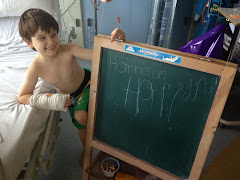
For those of you who know us well, you know we have four children, with Harrison being our youngest. I decided to focus on these guys for this post, as I feel that they are a credit unto themselves.
Mum took them in under her wing, and for the first two weeks they lived over at mum's house. When we realised how long we'd be in hospital with Harrison, Mum moved into our house.
Marlie is now 5 - her birthday party was held the morning of Harrison's admission to hospital. I deliberately, and in some ways, with a set of blinkers on to Harrison's worsening condition, still went ahead. My gut instinct said this would be the last party for a while. I am glad I did carry on - as I haven't been home since that day on 26th May. She has coped so well with everything, with a few 5 year old tantrums along the way, but has really been so good in general
Marlie has basically taught herself to write, with a little help from preschool and me. She has created many beautiful cards, and works of art - Many of which I have hanging around the room. It is these works of art and loving drawn cards and get well signs that have kept me going.

Sterling - well what can I say about Sterling. He is a gorgeous, funny 3 year old boy who loves bikes, Thomas and football. He is just such a funny kid, and very much the one who has struggled the most with Mum being away at Hospital with Harrison. He has also been the one that I have noticed to be growing up the quickest. Every time I talk to him on the phone a new word or phrase is said. My absolute favourite is how he has taken on mum's wording of "Oh My Goodness". It is said with such a cheeky smile. He too has done beautiful art work, and I know that these are special - as he was never really into art or craft before hospital.
Of the three of them as time goes on, he is dealing with the time and coming for visits the best.

Then there is Ella. Our beautiful little 2 year old, and Harrison's Bone Marrow donor. She has graciously undergone testing, being dragged around from one test to a doctors visit, and has barely shed a tear. I know if it were me - well I would have told me to get lost many times over, but not Ella. My only regret is putting her through this at all. She is so little and is now and will forever remain my hero.
Mum brought me in a photo of the 3 of them at preschool, which I have hung above Harrison's cot, to remind me of what I have waiting for me at home.
In all of this Mum and Scott have taken over. Mum does the day to day running around kids to preschool, cooking and general motherly stuff, while Scott has really picked up the reins and has become the Dad I always knew he could be. I spend my days here dealing with doctors and hospital. I used to spend my days looking after the kids, cleaning and paying bills. Scott does all the bills now, does much cleaning and has really stepped up to being there for the kids.
I am so proud of my mum and Scott. They are both still working full time, looking after the kids and running back and forth to the hospital whenever they can so I get to to see them and the kids as much as we can manage.
Mum has just been my tower of strength, she is my mum, always there for us - never thinking of herself only giving of herself what she can, and then some. She is the person who I most look up to in life, because she manages to smile and give me strength, even through her owns tears.
Scott has been here with me - a man who hates hospital and who struggled to be there in labour room for the good part of hospital stays, he has shown me how much he has grown. He took Ella in for he BM operation, stayed for days at a time here in the hospital during the early days, and when all things are said and done has been strong when I thought he would not cope, and coped better than he realises.
While there are certainly tough times ahead, I have come to realise one undeniable truth, that is how much I love and depend on these two people, for without both of them I would not have been able to cope as I have and without them I would be only half of the person I am today.
I will never take anything for granted again. Life is just far to precious.






















